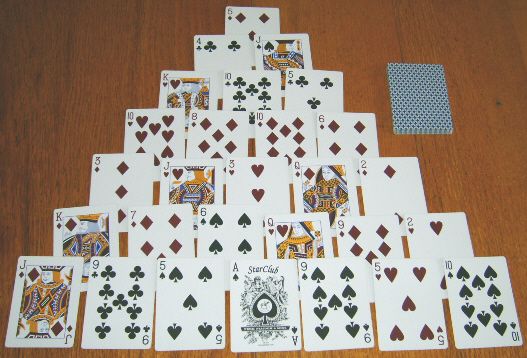Pyramid Solitaire
Players: 1
Ages: 6 and up
Cost: Free, if you own a deck of cards
Math Ideas: Addition
Questions to Ask:
What numbers are you hoping to draw?
Can you construct a pyramid that is impossible to win? How would you do that?
Can you construct a pyramid that can be won without drawing a single card? How?
Recently I got a lovely bit of feedback from a mom who said: Do you have any more games that my kids can play on their own? Rush Hour Jr. and Shut the Box are great because I know my son is learning even if I'm not able to play with him.
Now, I firmly believe that our kids learn best when they have casual, patient conversations about math with an adult that cares about them. But my new baby has been a stark reminder that I am not going to have time to talk deeply about math with each of my kids every day. Fortunately, I have some back-up plans.
Pyramid solitaire is a game my own parents taught me when I was in early elementary school, and I happily played it for years afterward. It's quick, it's tough to win, and all you need is a deck of cards.
How to Play
Deal out a pyramid of cards, with one card in the top row, two cards in the next row, and so on. You should end with seven rows, as shown in the picture.
The goal is to remove every card in the pyramid by making pairs that add to thirteen. Aces are 1, Jacks are 11, Queens are 12 and Kings are 13. If a card is fully uncovered, you can pair it with another card.
The player constructs the pyramid, then pairs off any cards she can, and then deals out the remaining cards one by one, pairing them with cards from the pyramid if possible.
If the player removes all the cards in the pyramid, she wins! If she deals out the last card and still has part of her pyramid remaining, she loses. In either case, the game lasts under five minutes and can be played time and again.
If you'd like, you can see an instructional video below:
Where's the Math?
Well, obviously this game is a great chance to learn the pairs of numbers that add to thirteen. Through this game, I learned over and over that 8+5=13, until it became a fact that I knew as fully and quickly as 2+3=5. Although the pairs that add to thirteen may not seem vital to a child's academic success, they can certainly bolster anyone's knowledge of basic addition and subtraction facts.
Everyone goes through life with a set of math facts that they just know. We use those facts to derive other facts. I don't know 19*50 off the top of my head, but I just know that 2*5=10, which means that 20*50 is 1000, so 19*50 must be 50 less than 1000. Using my known facts, I can determine that 19*50 is 950.
A first grader might not know what 8 + 9 is, but if she knows her doubles facts, she knows that 8+8 = 16. From there, she can count up one to determine that 8+9=17. The more facts that a child knows by heart, the more options she has when deriving a fact she doesn't yet know.
By the way, both of the examples above are the sorts of creative mathematical thinking that the Common Core standards promote. Kids still learn the traditional algorithm for each operation, but they are also learning a host of other strategies for solving arithmetic problems.
These new methods might seem unfamiliar to us as parents, but it's incredibly useful for their development as math thinkers. After all, how would you solve a problem like 1006 - 7? Would you borrow from the thousands place, then the hundreds, then the tens, and then subtract 16-7? Or would you use your common-sense understanding of the relationship between 1006 and 7 to find your answer? Hopefully your children will learn how and when to use these new strategies to save time and energy in math class.
Young kids can even play with a deck that doesn't include face cards. You deal out a pyramid with six rows, rather than seven, and then pair the cards that add to ten. The game is a bit easier, and perhaps not quite as fun, but I highly recommend this variant if your child is not yet confident with her pairs that add to ten.
Questions to Ask
This is a solitaire game, but you can always spy on your kids and pepper them with questions as they work. As they begin to learn the game, a great question is "Which cards do you hope to deal?" This gets them to look at all the cards in their pyramid and brainstorm the matching cards that add to thirteen.
Once your child is comfortable with the game, you can raise the stakes by asking them to construct their own pyramids. Can they build a pyramid that is impossible to win? What arrangement of cards makes the game impossible to win, and why? This question gets kids thinking strategically about the pyramid as a whole shape.
Once they've solved that question, you can ask the inverse: Can you construct a pyramid that can be immediately solved without dealing out any cards? This is a challenge! I had fun playing around with this question myself. If you're introducing the game to your kids, grab a second deck of cards and try it out yourself.



